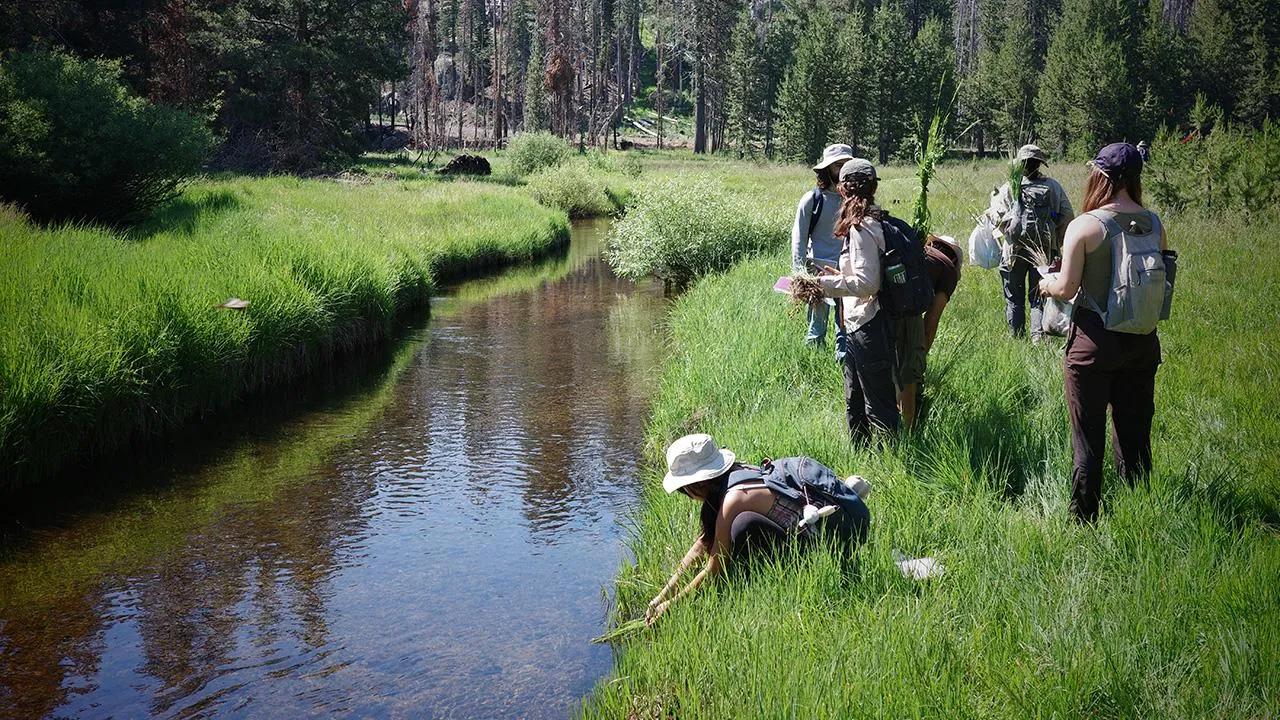
Elmer’s blue eyes and tinker’s penny: Lassen’s diversity is a scientist’s playground
For two weeks last July, UC Davis students roamed the meadows and forests of Lassen Volcanic National Park in far northeastern California. As they listened to the calls of flickers and watched for rare snowshoe hares, the students picked up wildflowers such as marsh marigold, grasses such as southern beaked sedge, and edible plants such as miner’s lettuce.
For class credit, the students wandered among whitebark pines, explored the park’s extensive meadows, gazed at its unique geological features, identified plants, and collected many plant species. They were benefiting from the university’s relationships linking the campus, the National Park Service and the University of California Natural Reserve System, which operates a field station in the park. The arrangement enables experiential learning like this field course for students and research opportunities for scientists to study the region’s unique flora and fauna. Park visitors reap the highlights of that research, park planners use it to guide their work, and residents in surrounding communities can get involved in local resource management.
Andrew Latimer, a professor in the Department of Plant Sciences, coordinates the academic research at the park. The arrangement “gives us access to some facilities at the park that we can reserve out to researchers and classes,” Latimer explained. “In exchange, they get more research and education done at the park. We provide a link from that remote corner of the state to the UC system.”

At the intersection of several mountain ranges and multiple ecosystem types, Lassen National Park offers a cornucopia of biological riches to study. Image credit: Marco Iboshi
For students, “there are so many opportunities,” said UC Davis’ Gary Bucciarelli, administrative director of the Lassen Field Station within the park, and five more sites within the larger UC Natural Reserve System. The Lassen area, he said, “is a completely understudied system. There are some of the state’s most understudied, rare, threatened and endangered species here.”
The field course here is co-taught by Dan Potter, a botanist and chair of the department. Joining him in teaching and co-creating the course is Steven Buckley, also a botanist and the liaison for the California Invasive Plant Management Team of NPS; he was formerly the park’s staff ecologist and project manager. The depth of their combined knowledge of the area’s natural history is “a gift” to those taking the course, Bucciarelli said.
Field botany course “a gift” to students
Lassen’s volcanoes rise at the juncture of three major geological formations: The northern end of the Sierra Nevada, the southern end of the Cascade Mountains and the western edge of the Great Basin. Four watersheds flow from the slopes that rise from 5,000 to above 10,000 feet high. In addition to majestic views, this geologic variety has produced wet and dry areas at a range of elevations.
That, in turn, has produced rich habitats with startling diversity. In the 27,000 years since Mt. Lassen pushed up from the Earth, six types of forests and more than 700 species of wildflowers have evolved.

Botanist Dan Potter, third from left, helps students identify plants during a summer field course held at Lassen Volcanic National Park and the UCNRS’s Lassen Field Station. Image credit: Aemilia Thompson/UC Davis
“Students in the class inventory the biodiversity and think about what’s there,” Bucciarelli added. “They benefit our long-term understanding of what we have in California and how to value that.”
They also collect and prepare specimens for the UC Davis Center for Plant Diversity Herbarium, a kind of pressed-plant library used by researchers around the world. Last summer, students in the field course contributed 268 specimens.
“Most importantly, they overwhelmingly expressed how much they valued the opportunity for experiential, field-based learning,” Potter wrote of the experience.

Students spotted a flowering Tinker’s penny (Hypericum anagalloides) at Lassen National Park growing alongside the sticky pink tentacles of carnivorous sundews. Image credit: Ian Ferrer/UC Davis
Partnerships, benefits & synergies
The Lassen Field Station was established at Lassen Volcanic National Park in 2019. It’s the sixth station in the system administered by UC Davis. The larger UC Natural Reserve System embraces 42 natural reserves likened to a library of ecosystems throughout California.
The summer field course, Potter wrote, illustrates “the extraordinary suitability of Lassen Volcanic National Park as a location to illustrate the complexity and diversity of California flora and its history, as well as the value of teaching this material in the field.”
For more information reach out to Gary Bucciarelli at gbucciarelli@ucdavis.edu